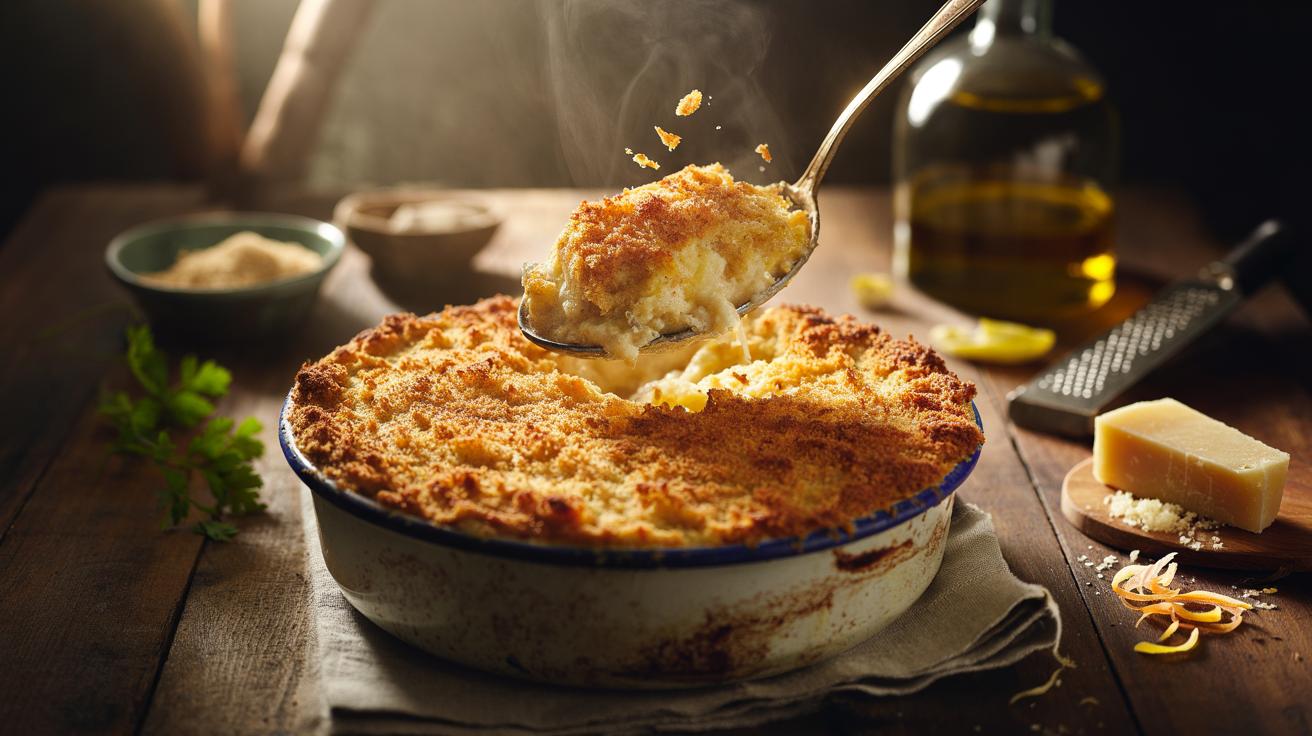In a nutshell
- 🍞 A crisp breadcrumb topping adds crunch, aroma, and contrast, creating vital textural balance with soft fillings and stopping palate fatigue.
- 🥖 Choose crumbs wisely: Panko for wetter casseroles, fresh sourdough for flavourful toastiness, and fine dry crumbs for delicate pies—match flake size to moisture.
- 🔥 Technique matters: coat crumbs with butter or olive oil, pre-toast 2–3 minutes, bake middle then top rack, finish under the grill; keep steam away and add hard cheese for deeper browning.
- 🌶️ Flavour upgrades: lemon zest, herbs, chilli, and nuts; regional twists like Sicilian mollica atturrata, cheddar-laced crumbs, or a sprinkle of dukkah.
- 📏 Practical science: crumbs act as a porous barrier that boosts the Maillard reaction; use about 1 cup per medium casserole and add just before the final bake for maximum crunch.
The humble casserole has a comforting reputation, yet its charm often wilts when everything inside is uniformly soft. Enter the breadcrumb topping, a simple tactic that turns a placid bake into a textural performance. By scattering seasoned crumbs across a bubbling surface, you introduce crunch, aroma, and contrast that frame the dish beneath. The pleasure of a great casserole lies in tension: creamy depths lifted by a crisp lid. Whether you’re rescuing a luxuriant fish pie or rounding out a lentil bake, the right crumb behaves like punctuation—adding rhythm, brightening flavour, and ensuring each spoonful ends with a satisfying, audible snap.
Why Texture Matters in a Spoonable Dish
A casserole’s centre is engineered for tenderness: slow-cooked vegetables, shredded meats, béchamel-bound pasta. Without a counterpoint, that softness can taste heavy, even monotonous. A crisp breadcrumb crust supplies a second dimension—sound, bite, and minor resistance—making the filling feel silkier by contrast. Chefs call this textural balance, and it’s as psychological as it is culinary. When your teeth meet a brittle layer before hitting a creamy core, the palate resets with each mouthful, preventing fatigue and allowing spices, herbs, and dairy sweetness to register more clearly.
There’s also practical chemistry at work. Breadcrumbs form a porous barricade that absorbs rising steam, so the top browns rather than steams. That encourages the Maillard reaction, drawing out nutty, toasty notes that amplify savoury flavours below. In liquid-heavy bakes—think tomato-rich aubergine parmigiana—the crust reins in excess moisture, creating a more cohesive slice. The result is not simply crunch for crunch’s sake, but a calibrated contrast that makes the whole dish taste better.
Choosing the Right Breadcrumbs
Not all crumbs behave alike. Panko—the airy, jagged Japanese style—produces maximal crunch because its shards create more surface area. It excels over high-moisture fillings. By contrast, fresh breadcrumbs made from day-old sourdough toast beautifully and carry flavour, while fine dry crumbs offer a more uniform, sandier coat that’s ideal for delicate pies. Match crumb structure to filling texture: bigger flakes for wetter casseroles, finer crumbs for silky interiors. Wholemeal crumbs add a nutty depth; gluten-free versions made from corn or rice bread can work if you balance fat and baking time.
| Topping Base | Best Fat | Oven Temp | Result |
|---|---|---|---|
| Panko | Neutral oil + butter | 200–220°C | Ultra-crisp, light, golden shards |
| Fresh sourdough crumbs | Butter or olive oil | 190–200°C | Toasty, flavour-rich, slightly chewy bite |
| Fine dry crumbs | Olive oil | 180–190°C | Even browning, delicate crunch |
Fat, Heat, and Timing: The Science of a Crisp Crumb
Breadcrumbs need fat to brown and to resist sogginess. Toss them with melted butter for rich flavour or olive oil for peppery lift; aim to lightly coat rather than saturate. Salt early so the seasoning disperses. Pre-toasting crumbs in a dry pan for 2–3 minutes jump-starts colour and guarantees crunch. Layer them on just before the final bake, and resist covering the dish tightly—steam is the enemy of texture. If your filling is very wet, cool it for a few minutes first so the crumb isn’t immediately overwhelmed.
Heat placement matters. Bake on a middle rack until the centre is hot, then move to the top third to encourage browning. A brief blast under the grill at the end delivers a glassy, shattering crust. For make-ahead meals, store the crumb mixture separately and add before reheating. Stir a spoon of hard cheese like Parmesan into the crumb to lower its moisture threshold and intensify browning. The equation is simple: balanced fat + dry heat + last-minute assembly equals reliable crunch.
Flavour Add-Ins and Regional Twists
A breadcrumb topping also works as a spice rack. Stir through finely grated lemon zest and parsley for fish pies, or smoked paprika and thyme for bean bakes. A pinch of chilli flakes in the crumbs offers heat that blooms as the crust browns. For a coastal nod, swap 10–15% of the crumb for crushed crackers or dried seaweed flakes. Nuts—almonds, hazelnuts, or pistachios—bring oil and fragrance; blitz to coarse rubble and fold in sparingly to avoid greasiness.
Regional cues add character. In Britain, cheddar-laced crumbs elevate cauliflower cheese without overshadowing the sauce. Sicilian-style mollica atturrata—olive oil–toasted breadcrumbs with anchovy and garlic—gives tomato bakes savoury depth. A Middle Eastern touch might include dukkah or cumin with coriander seed. Vegan fats like rapeseed oil or plant-based butter brown as effectively when the oven is properly hot. Whatever the twist, keep the ratio sensible: about one loosely packed cup of crumbs per medium casserole, enough to create a persistent, audible crust without smothering the dish.
The genius of a breadcrumb topping isn’t novelty; it’s balance. A crisp crust keeps rich fillings lively, steers moisture, and adds flavour that resonates through each bite. Think of it as architecture for comfort food—structure above, softness below. With the right crumb, a measure of fat, and attentive heat, you can transform weekday staples into plates that crackle and sing. Next time you bake, what combination of crumb, fat, and seasoning will you choose to give your casserole that irresistible, golden finish?
Did you like it?4.5/5 (29)
